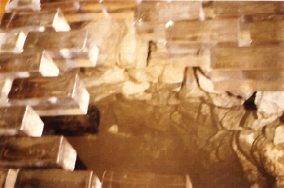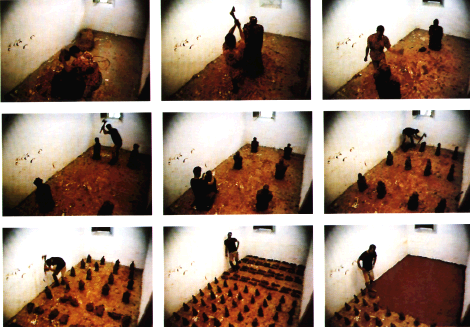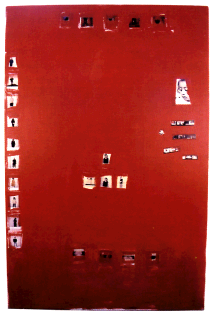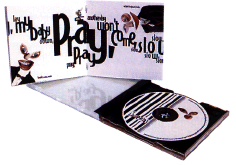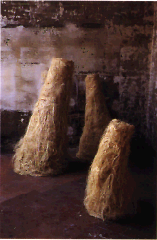Indisciplines
APM: As we said before, this is an inevitably difficult exhibition. Especially difficult for the commissioners that we have to face a heterogeneous global, very rare as a whole. You think that the work of the commissioner will be to be taken away by the pleasant seduction of a glittering and absolutely coherent aesthetic panorama, in which your supreme criterion will subtly subtlete some open questions and, suddenly, it is as if someone you were inviting us to enter; Once you've crossed the door and you feel inside, it's actually out and it rains: the rain is the enthusiastic work of the students. The work is vast, diverse and surprising. It falls to bursts, like a spray, in a soft or fierce way. The first thing we do is to quickly find shelter, and shelter is a taxonomy (forgive me the metaphorical excesses). Of course, we do not start from scratch, the Massana School already has some drawers made: Jewelery, Engraving, Graphic Design, Sculpture, etc. But this classification immediately turns out to be disappointing and not very interesting. In addition, there are a few "<< between disciplines >> workshops that mix techniques and processes, and there are students stubborn to skip the limits of what they are supposed to be studying ...
We agree that we have to invent a more suggestive classification that allows us to read the world of these works in a more risky way. Perhaps a classification like that of animals popularized by Foucault, who cites Jorge Luis Borges, who, in turn, attributes it to a Chinese encyclopedia that a certain Doctor Kuhn would have had in his hands (citation that we can save the reader) . This classification could become something like this:
1. Work of students who work as a team.
2. Incomplete works
3. Works of ceramics students who do not use ceramic materials.
4. Other works.
5. Exercises that you notice are the work of designers.
6. Works done after 1950.
7. Custom work.
ABV: Well, it seems to me that the challenge is that the exhibition proposes an approach to the work that is able to activate several layers of meaning in each one of the objects. Although most of the objects that we present are not made only to be contemplated but mainly to be used and consumed and, therefore, they will be studied from criteria of production economy, functionality and perhaps at some time (both good soon) from ecological criteria, all have other possibilities of relationship with us. Especially, now they are not yet part of the consumer system, living in a pre-natal state, in a testing laboratory ...
It would be interesting that the viewer could establish varied exchanges, as we did while selecting them. I would like the viewer to find this communication record through which it is possible to converse with the object without having to know its language codes in depth or with the intention of appreciating it from a point of purely aesthetic view. To propose an exchange with the object that reveals how it acts symbolically and also how it transports political content, that is to say, show it so that it reveals the different roles that can play when it works within the complex cultural system. After all, we find a lot of objects that want to fill our spaces, some even model them (the models of interior design), and will thus be decisive in our relationships with the environment and with others.
RAB: Yes, as you say, for me it is also difficult to curate an exhibition as well as in which we start from work done in the School but we do not want it to be the end of course exhibition that illustrates the different programs of each one of the specialties We have found many surprises. That surprises are, then, the thread! We can propose a group that does not respond to techniques or work processes of the different specialties. In fact, many works go beyond their own specialty and also the students' course, because when we saw the << in situ >> works in the workshops, we were not interested in this data at any time. Instead, one of the things that surprised us most is this ability that has some work to propose a different way of seeing the world, beyond the academic value of the exercises. On the other hand, we have been able to observe in a great number of works some references that were repeated: for example, the preoccupation to investigate the own identity of the author, the interest by the introspection, the tension between the inner world and the defora, the "I" and the "other", and also a strong dichotomy between the rural world and the urban world.
ABV: Yes, but apart from what each work can do for itself, what worries me is how to show it as part of a set and how in this show we can offer an interpretation about some aspects of our culture .
RAB: Perhaps this exhibition for the students could be like a general essay, a rite of passage, of initiation? Maybe we three also have to be undisciplined as most of the students and teachers of this School are. Disciplined in the sense of knowing the discipline well and then transgress her in a creative way.
APM: The desire to skip the limits of a particular discipline may be something that characterizes one of the ways of doing art in the second half of the 20th century. Perhaps in a while this will be seen as a stylistic component, just as there has already been a critical line that has wanted to analyze the work of the first vanguards (especially in the field of design) from from a strictly formal point of view and not from ethical, social or rational approaches, which seemed to be at the origin of modern movements. Perhaps someone from here a hundred years-if we were lucky enough to get close to looking at this catalog-I would find this exhibition as coherent as an exhibition of the Werkbund, as obvious as a manifesto, but now ...
ABV: I have not observed in most of these works this interdisciplinary direction of these last decades nor the need to feel itself debated in the uncertainties and anxieties of the time. Except in some options, such as jewelry proposals, where in the approach of some personal ornaments there was a clear awareness of the moment we lived, a certain intention to recover a spiritual and profound dimension of culture lost in the midst of so much formal masturbation sense, inheritance of that face of the modernity you were talking about, Antoni.
APM: Yes, I deeply imitate the need for consistency. I am (wrong) accustomed to the formal discourse supported on a theoretical basis or, at least, in a plot line. I would like this exhibition to be clear as a Jackson Pollock or as a Gerrit Rietveld, or as a Ezio Manzini. But finding something in the production of the School is absolutely impossible. A school is a school and, contrary to what the school name seems to mean, I can not find school anywhere. A student, maybe I would not even question this. (By the way, one of the aspects that most fascinates me of the Bauhaus is not so much its avant-garde position but its internal coherence at the figurative level. Is this attributable to a neoplasticist? I do not believe it).
ABV: In the visual arts the same is true because, of course, today we can not talk about trends from the point of view of a coherent shared language but I think we can talk about common concerns that have a lot to do with the failure of a damn modern project Among other things, we live the crisis of the welfare society, the turning point in the << sustainability >> of the planet, a new technical-scientific utopia that we are already skeptical of believing, and a new crisis of languages, this Once the traditional and the modern, disabled both to react against homogenization and the reduction of personal, social and cultural reality. That is why the coincidence of many works that we have seen in vindicating personal, sensory, intuitive and direct experience of things more than a teenage shelter seems to me to be an exciting revulsion and a symptom of time. Perhaps, however, we could ask each other a bit more about it ...
APM: Well, the students, as I said, live this reality of the time and what they want is to move around the world in the most diverse directions. There is a movie of the Coen Brothers called Arizona Baby, in which Nicholas Cage, a small fledgling mat married to a police officer, faced with the impossibility of having children decides to steal a child, one of five twins. When you open the quintuple crib to do the maliciousness, babies start escaping their random directions. When you get caught one, the others have crashed into the hall of the house or farther ... This sequence of Steadycam is difficult to explain but it is exactly the image that comes to mind when I think of this exhibition.
RAB and ABV: Ha, ha, has what indiscipline!
Rosa Amorós Bernadó
Assumpta Bassas Vila
Antoni Pérez Mañosas



